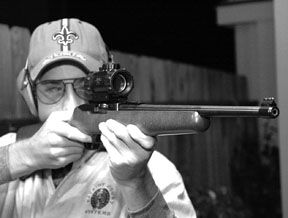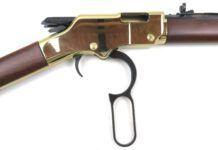
In September 2005, Sturm Ruger announced production of a compact version of its prolific 10/22 semi-automatic rifle, $275. Christened the 10/22CRR, we ordered one immediately. When it arrived, our first impression was that this carbine was not merely shorter; it, in fact, seemed scaled down from the original design.
We couldn’t help but smile at the compact 10/22’s size, but the real fun began when we went shopping for additional rimfire semi-automatic carbines to fill out a test roster. We acquired a Marlin 70PSS with composite stock, $318. The Marlin carbine differed from the Ruger in several ways, not the least of which was that it can be broken down by removing the barrel for transport. Marlin refers to this model as the Papoose. Our third gun was the Armscor AK 22, $220. The AK22 closely resembles an AK47, down to the replica magazine.
All three guns arrived with a single magazine. Further, each carbine could be viewed as a youth model, a training device, or both. But would the reduction of size compromise the time-proven 10/22 design? Would the Armscor AK22’s big-gun appearance interfere with function or reliability? Would the integrity of lockup between barrel and receiver of the Marlin show signs of failure after repeated applications? Could three conceptually different models produce the same level of accuracy?
To find out, we shot the guns at 50 yards using a Caldwell Tack Driver ($33 unfilled from <www.midwayusa.com>). The Tack Driver is a sand-filled support with a left- and right-side chamber that forms an 11-inch-long channel to grip the forend. Our selection of test ammunition included the Federal Classic 40-grain solid copper-plated rounds and two Remington products. They were the Remington High Velocity 36-grain HP and the Remington Eley Target Rifle 40-grain LRN ammunition.
Here’s what we found when we tested the guns head to head:
The 10/22 features a fast-cycling action fed from a rotary magazine that holds ten rounds. Ruger offers thirteen different models based on this design, including those with solid wood, laminate, and composite stocks ranging in price from $275 to $314. Aftermarket, there are many more custom parts available. The subject of this test was the company’s latest variation. The 10/22CRR features the same action as its bigger brothers, but the barrel was barely longer than 16 inches and length of pull had been scaled back to just 12.5 inches. The handsome walnut stock was also proportionately smaller from top to bottom and thinner from side to side. The result was an unloaded weight of only 4.5 pounds. Overall length was about 33 inches, shorter than the Marlin but still not as portable as the 70PSS.
We found it easy to whip the 10/22CRR from target to target. The stock was straight at the comb and continued in one smooth piece to envelop the action and cover all but the final 6 inches of the barrel. The pistol grip was thin. We really liked the way the action fit into the stock like a fine jigsaw puzzle. All the edges were clean and smooth, including the trigger and the trigger guard. The magazine release was nestled underneath. All the steel was dark blue. The rotary magazine was clear plastic. Inside you could see the turbine-like fixture pick up each round as it was loaded. Above was a rear sight similar to a pistol assembly. Elevation was adjusted by a set screw, and a light-gathering filament offered two green dots to complement the red filament of the front sight.
Ruger dovetailed the front sight into a band at the muzzle, tapped the receiver, and supplied a Weaver scope mount. We wish Ruger had also supplied some plugs to screw into the holes while we tested with the scope mount removed.
The Ruger 10/22 fit our bench well. The stock settled into the bag better than the Marlin’s short stock and the AK22’s busy underside, whose magazine and grip interfered. We thought the rear sight was hard to use; still, under difficult conditions we were able to print five-shot groups that measured about 1.3 inches on average. This placed the Ruger 10/22CRR first overall in [PDFCAP(2)].
We took advantage of the supplied scope mount to test fire with an inexpensive but durable 1X red dot scope we purchased for $79 from the Bushmaster rifle website (www.bushmaster.com). With the wide view provided by the 30mm lens, our ability to zero in on targets with the 1-MOA red dot was limited only to our testers’ individual distance-vision quality. We were also able to acquire targets faster using the red-dot unit. By supplying a precision scope mount, Ruger made its 10/22CRR optics-ready, which gave it another edge over the other guns.
[PDFCAP(3)]
Along the right side of the Armscor AK22 was an engraving that clearly read, “Arms Corporation of the Philippines, AK47/22.” But the printed material supplied with this weapon read, “Manual for Model AK22 Semi-Automatic,” and that is the model designation on the armscor.net website. Further, the heading for both the spec sheet and the operating instructions refer to this gun as the Squires Bingham Model AK 22 — most likely referring to the famous Manila retail gun store, Squires Bingham and Company.
We found that the AK22 was bulkier than either the Marlin or Ruger products. This was primarily due to its overall height, accented by the removable magazine, pistol grip, and tall sights. Barrel length measured slightly more than 18 inches. The Armscor AK22 closely resembles the centerfire AK47, which is commonly chambered for the 7.62X39mm cartridge. Certainly, the AK22 can be called a trainer for the AK47, except for the select-fire switch and the lack of recoil provided by .22 LR ammunition.
The magazine looked like the real thing, but was actually a shroud covering a single-column 10-round magazine. The magazine release was integrated into the rear edge of the magazine body. The angle of magazine insertion proved clumsy. But the safety lever and bolt positions were pleasingly close to the original design. The sights, especially the rear sight blade, were closer to being like modern pistol sights from the shooter’s perspective. But adjustment for elevation was a crude slide, which changed sight radius as well. The front sight blade was partially protected by a hood.
The finish and machining were adequate, we thought. Not so much that the gun was ugly, but we would say that the Armscor AK22 was closer to a mess kit than to fine china. The stock was blond wood, and the wood pistol grip was a little loose. Parts of the forend were also wobbly. The trigger, however, was exceptionally smooth. Internally the bolt looked sturdy and smooth. The feed ramp looked precise as well. If the exterior of this gun was marginal, then most of the time spent on this gun was on its action.
At the range we discovered that we liked the sights on the AK22 better than the buckhorn-type sights on the Marlin 70PSS or the filament sights found on the Ruger 10/22CRR. This was good news because the availability of proper scope mounts for this model is limited. The Armscor AK22 ran reliably without cleaning or asking for additional lubrication. We were concerned that it might not run on the Remington Eley ammunition because those rounds produced less velocity in the other carbines and the warning, “Use High Velocity 22LR Only,” was engraved on the receiver. But no such problems arose. Clearly, the AK22 was happiest firing the fastest-flying ammunition, with group sizes ranging from 1.0 to 1.4 inches in heavy wind. The Armscor AK22 might be intimidating cosmetically, but it was a pleasure to shoot.
[PDFCAP(4)]
Opening the slim cardboard box we found a 24-inch-long by 9-inch-wide cloth gun rug. Inside was a gun which sported a slender black composite stock with stainless steel receiver. A stainless-steel barrel fit snugly into its own compartment. Connecting the two pieces created a 35.5-inch-long 3.3-pound weapon. The 16.5-inch barrel lacked a forend, but it was fitted with a takedown nut at the chamber end. The sights were attached to the barrel. The rear sight was elevation adjustable by a sliding block rear with buckhorn style blade. Windage adjustment was by impact or drift. The front sight was a high-visibility orange blade protected by a Marlin Wide-Scan hood that was relieved at the top to provide a limited amount of light. In our opinion, the orange front sight did not add appreciably to the quality of the sight picture.
We found it very easy to attach the barrel to the receiver. The key was to match the flat surface of the barrel to the flat surface in the receiver, then tighten the takedown nut, which could be tightened by hand or with a supplied spanner wrench. A deep groove was also cut into the ring, which was designed to fit a common coin.
Even with the ring not completely tight, we found that the Papoose would run reliably without any discernible loss in accuracy. The 70PSS was fed from a seven-round single-column magazine. A lever directly behind the magazine well released the magazine. We found the slide release on the right side of the receiver just above the trigger guard, and we saw the crossbolt safety at the rear of the trigger guard. Marlin machined the top of the receiver to form a 3/8-inch scope mount. We would have preferred Weaver dimensions or a simple drill-and-tap job.
Shooting the Marlin 70PSS, we obtained our best accuracy firing the Remington Eley Target rifle ammunition. Our best single group of the test measured 0.8 inch at 50 yards with these rounds, matching the Ruger’s best effort. The Marlin produced an average group size of 1.4 inches for both the Federal and Remington Eley ammunition. The trigger on the Marlin felt heavy at first, but still registered 6 pounds, equal to the Ruger in resistance but different in feel. The Marlin finished third overall in accuracy, despite tying the Ruger for best single group.
We encountered no problems with the operation or maintenance of this rifle, which may be just the right size for the beginner or small-framed adult. Its compact size also makes the Marlin 70PSS appealing.
Other Guns
Looking in the archives for guns similar to the Ruger 10/22CRR, Marlin 70PSS, and the Armscor AK 22, we found very little to help us. In terms of youth model semi-automatic rimfire rifles or ultra compact models, we did come up empty. Broadening our search to include longer-barrel models, we found one test (September 2001) that included four upgraded Ruger 10/22 rifles. Based on overall length (35 inches), the closest match was the Magnum Research Magnum Lite. The 2001 MSRP was $600, complete with a Hogue rubber overmolded stock and carbon-fiber barrel fit with a single port compensator. The other three rifles were a Briley Sporter, a Clark Custom Guns Hunter, and Ruger’s TNZ, complete with laminated thumb-through stock. These rifles measured 38 to 40 inches long and featured numerous custom features and refinement. The Ruger and the Clark rifles sold for $600 and $630 respectively, and the Briley cost a whopping $1100. None of these guns were meant to be easy packers or entry-level models, and all three were tested with target scopes. As a result, all four guns consistently printed 0.5- and 0.6-inch groups at 50 yards. In terms of illustrating the potential of the Ruger 10/22CRR, this should serve as further evidence as to why it was our top pick.
In the February 2001 issue, we tested one semi-automatic along with two bolt-action .22 LR rifles. The Thompson Center 22 Classic offered a 22-inch barrel, and the test was conducted with a six-power scope. Accuracy with two of three test rounds was approximately 0.75 inch at 50 yards. Firing ammunition that was common to our current test (the Remington High Velocity rounds), the 22 Classic was only able to manage an average group measuring 1.8 inches. We still like the Ruger 10/22CRR better, however.
Going back to June 1999, we tested two autoloaders from Ruger, the 10/22RB and the 10/22RP plus two models from Remington, the 597 and the 597 Sporter. Prices at that time were $225 for the Rugers and only $159 for the Remingtons. Each rifle came with open sights, but we fired the guns with scopes in place. None of the five different brands of ammunition appear in our current test. The Ruger RB (wood stock) was the top shooter, averaging 1-inch groups or better with four of five test ammunitions. The Remington 597 (polymer stock) proved better than the 597 Sporter and actually shot a little better than the polymer-stocked Ruger to finish second. Although a youth edition is not currently available, today’s price for a Remington 597 with carbon-steel barrel is still just $159, making it a very good buy in our opinion.
Gun Tests Recommends
• Ruger 10/22CRR .22 LR, $275. Best Buy. The most accurate gun in the test was also the most versatile. It’s a plinker, a squirrel gun, or a competition rifle for a youngster. Any way you look at it, the 10/22CRR is a sure winner.
• Armscor AK 22, 22LR, $220. Buy It. For all its intimidating appearance, the AK 22 is simply a good, solid rimfire semi-automatic. AK47 owners who want a cheaper training alternative can upgrade this ranking to an Our Pick.
• Marlin 70PSS Papoose .22 LR, $318. Buy It. The Papoose is just right for the small beginner, but portability is its greatest appeal. Like Jell-O, there is always room for the Marlin 70PSS.
-Text and photos by Roger Eckstine from Gun Tests team field and range evaluations.





























